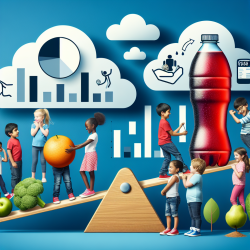The Hidden Dangers of Sugar-Sweetened Beverages for Children
As a speech-language pathologist dedicated to improving children's outcomes, I am always on the lookout for research that can inform our practice and improve the health and well-being of the children we serve. A recent study titled "Intake of sugar sweetened beverages among children and adolescents in 185 countries between 1990 and 2018: population based study" offers critical insights into a growing global health concern: the consumption of sugar-sweetened beverages (SSBs) among children and adolescents.
Understanding the Data
The study, which analyzed data from the Global Dietary Database, found that the mean global intake of SSBs among children and adolescents was 3.6 servings per week in 2018. This intake varied significantly across regions, with Latin America and the Caribbean showing the highest consumption rates. The study also revealed that SSB intake increased by 23% from 1990 to 2018, paralleling the rise in obesity rates among young people.
Key Findings
- Regional Disparities: SSB consumption was highest in Latin America and the Caribbean, with an average of 9.1 servings per week, while South Asia had the lowest at 1.3 servings per week.
- Age and Urbanization: Older children, those living in urban areas, and those with parents of higher education levels consumed more SSBs.
- Trends Over Time: The most significant increase in SSB consumption was observed in sub-Saharan Africa, with a 106% rise from 1990 to 2018.
Implications for Practitioners
These findings underscore the importance of addressing SSB consumption in our work with children and adolescents. As practitioners, we can play a crucial role in educating families about the health risks associated with high SSB intake, such as obesity, type 2 diabetes, and cardiovascular disease. Here are some strategies to consider:
- Education and Awareness: Incorporate information about the risks of SSBs into educational materials and sessions with families.
- Advocacy for Policy Change: Support policies that aim to reduce SSB consumption, such as taxes on sugary drinks and restrictions on marketing to children.
- Promote Healthy Alternatives: Encourage the consumption of healthier beverages, such as water and unsweetened milk, in schools and at home.
Call to Action
To effectively address this issue, further research is needed to understand the specific factors driving SSB consumption in different regions and demographic groups. As practitioners, we should advocate for and participate in research efforts that aim to develop targeted interventions to reduce SSB intake among children and adolescents.
For those interested in delving deeper into this research, I highly recommend reading the original study. It provides a comprehensive analysis of SSB consumption trends and offers valuable insights for informing policy and practice. Intake of sugar sweetened beverages among children and adolescents in 185 countries between 1990 and 2018: population based study.










